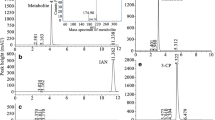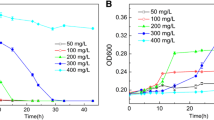Abstract
Growth of Delftia acidovorans MC1 on 2,4-dichlorophenoxyacetic acid (2,4-D) and on racemic 2-(2,4-dichlorophenoxy)propanoic acid ((RS)-2,4-DP) was studied in the perspective of an extension of the strain’s degradation capacity at alkaline pH. At pH 6.8 the strain grew on 2,4-D at a maximum rate (μmax) of 0.158 h−1. The half-maximum rate-associated substrate concentration (Ks) was 45 μM. At pH 8.5 μmax was only 0.05 h−1 and the substrate affinity was mucher lower than at pH 6.8. The initial attack of 2,4-D was not the limiting step at pH 8.5 as was seen from high dioxygenase activity in cells grown at this pH. High stationary 2,4-D concentrations and the fact that μmax with dichlorprop was around 0.2 h−1 at both pHs rather pointed at limited 2,4-D uptake at pH 8.5. Introduction of tfdK from D. acidovorans P4a by conjugation, coding for a 2,4-D-specific transporter resulted in improved growth on 2,4-D at pH 8.5 with μmax of 0.147 h−1 and Ks of 267 μM. Experiments with labeled substrates showed significantly enhanced 2,4-D uptake by the transconjugant TK62. This is taken as an indication of expression of the tfdK gene and proper function of the transporter. The uncoupler carbonylcyanide m-chlorophenylhydrazone (CCCP) reduced the influx of 2,4-D. At a concentration of 195 μM 2,4-D, the effect amounted to 90% and 50%, respectively, with TK62 and MC1. Cloning of tfdK also improved the utilization of 2,4-D in the presence of (RS)−2,4-DP. Simultaneous and almost complete degradation of both compounds occurred in TK62 up to D = 0.23 h−1 at pH 6.8 and up to D = 0.2 h−1 at pH 8.5. In contrast, MC1 left 2,4-D largely unutilized even at low dilution rates when growing on herbicide mixtures at pH 8.5.
Similar content being viewed by others
References
AA Esener JA Roels NWF Kossen JWH Roozenburg (1981) ArticleTitleDescription of microbial growth behaviour during wash-out phase; determination of the maximum growth rate J. Appl. Microbiol. Biotechnol. 13 141–144 Occurrence Handle10.1007/BF00703042
A Ehrig RH Müller W Babel (1997) ArticleTitleIsolation of phenoxy herbicide-degrading Rhodoferax species from contaminated building material Acta Biotechnol. 17 351–356 Occurrence Handle10.1002/abio.370170411
F Fukumori RP Hausinger (1993a) ArticleTitleAlcaligenes eutrophus JMP 134 “2,4-dichlorophenoxyacetate monooxygenase” is an α-ketoglutarate dependent dioxygenase J. Bacteriol. 175 2083–2086 Occurrence Handle1:CAS:528:DyaK3sXitVyitbY%3D
F Fukumori RP Hausinger (1993b) ArticleTitlePurification and characterization of 2,4-dichlorophenoxyacetate/α-ketoglutarate dioxygenase J. Biol. Chem. 268 24311–24317 Occurrence Handle1:CAS:528:DyaK3sXlvFyhsLk%3D
D Hoffmann S Kleinsteuber RH Müller W Babel (2003) ArticleTitleStructural organization and localization of the chlorocatechol pathway in the 2,4-D degrading alkalitolerant strain Delftia acidovorans P4a Microbiology 149 2545–2556 Occurrence Handle1:CAS:528:DC%2BD3sXnslGnsLY%3D Occurrence Handle10.1099/mic.0.26260-0
JHJ Leveau AJB Zehnder JR Meer ParticleVan der (1998) ArticleTitleThe tfdK gene product facilitates uptake of 2,4-dichlorophenoxyacetate by Ralstonia eutropha JMP 134(pJP4) J. Bacteriol. 180 2237–2243 Occurrence Handle1:CAS:528:DyaK1cXisVCgt7g%3D
P Mai SO Jacobsen J Aamand (2001) ArticleTitleMineralization and co-metabolic degradation of phenoxyalkanoic acid herbicides by a pure bacterial culture isolated from an aquifer Appl. Microbiol. Biotechnol. 56 486–490 Occurrence Handle1:CAS:528:DC%2BD3MXmsFKgsrw%3D Occurrence Handle10.1007/s002530000589
RH Müller KD Markuske W Babel (1985) ArticleTitleFormate gradients as a means for detecting the maximum carbon conversion efficiency: correlation between formate utilization and biomass increase Biotechnol. Bioeng. 17 1599–1602 Occurrence Handle10.1002/bit.260271114
RH Müller W Babel (1994) ArticleTitlePhenol and its derivatives as␣heterotrophic substrates for microbial growth – an energetic comparison Appl. Microbiol. Biotechnol. 42 446–451
RH Müller W Babel (1995a) ArticleTitleDetermination of Ks-values during growth of Alcaligenes eutrophus JMP 134 on phenol, 2,4-dichlorophenoxyacetic acid and fructose Acta Biotechnol. 15 347–353 Occurrence Handle10.1002/abio.370150406
RH Müller T Bley W Babel (1995b) ArticleTitleTransient state cultivation as a means for determining maximum growth rates of microorganisms in inhibition kinetics J. Microbiol. Meth. 22 209–219 Occurrence Handle10.1016/0167-7012(94)00075-I
RH Müller S Jorks S Kleinsteuber W Babel (1999a) ArticleTitleComamonas acidovorans MC1: a new isolate capable of degrading the chiral herbicides dichlorprop and mecoprop and the herbicides 2,4-D and MCPA Microbiol. Res. 154 241–246
RH Müller RA Müller Y Jahn W Babel (1999b) A biotechnological approach of detoxifying herbicide-contaminated building rubble BC Alleman A Leeson (Eds) Bioremediation of Nitroaromatic and Haloaromatic Compounds NumberInSeriesVol 5(7) Battelle Press Columbus, Richland 143–148
RH Müller RA Müller Y Jahn W Babel (2000) Bioremediation of building material contaminated with herbicides DL Wise DJ Trantolt EJ Cichon (Eds) Remediation of Hazardous Waste Contaminated Soils EditionNumber2 Marcel Dekker New York 121–131
RH Müller S Kleinsteuber W Babel (2001) ArticleTitlePhysiological and genetic characteristics of two strains utilizing phenoxypropionate and phenoxyacetate herbicides Microbiol. Res. 156 121–131 Occurrence Handle10.1078/0944-5013-00089
K Nickel MJF Suter HPE Kohler (1997) ArticleTitleInvolvement of two α-ketoglutarate-dependent dioxygenases in enantioselective degradation of (R)- and (S)-mecoprop by Sphingomonas herbicidovorans MH J. Bacteriol. 179 6674–6679 Occurrence Handle1:CAS:528:DyaK2sXnt1aku78%3D
KH Oh OH Tuovinen (1990) ArticleTitleDegradation of 2,4-dichlorophenoxyacetic acid by mixed cultures of bacteria J. Ind. Microbiol. 6 275–278 Occurrence Handle1:CAS:528:DyaK3MXit1Ggurc%3D Occurrence Handle10.1007/BF01575873
A Pao IT Paulsen MH Saier SuffixJr (1998) ArticleTitleMajor facilitator superfamily Microb. Mol. Biol. Rev. 62 1–14 Occurrence Handle1:CAS:528:DyaK1cXitF2jsLg%3D
DH Pieper W Reineke KH Engesser HJ Knackmuss (1988) ArticleTitleMetabolism of 2,4-dichlorophenoxyacetic acid, 4-chloro-2-methylphenoxyacetic acid, and 2-methylphenoxyacetic acid by Alcaligenes eutrophus JMP 134 Arch. Microbiol. 151 365–371 Occurrence Handle10.1007/BF00406566
Saari ER, Hogan DA & Hausinger RP (1999) Stereospecific degradation of the phenoxypropionate herbicide dichlorprop. J. Mol. Catal. B: Enzymatic–6: 421–428
KM Schleinitz S Kleinsteuber T Vallaeys W Babel (2004) ArticleTitleLocalization and characterization of two novel genes encoding stereospecific 2(2,4-dichlorophenoxy)propionate cleavage in Delftia acidovorans MC1 Appl. Environ. Microbiol. 70 5357–5365 Occurrence Handle1:CAS:528:DC%2BD2cXnslSqu7k%3D Occurrence Handle10.1128/AEM.70.9.5357-5365.2004
A Suarez A Güttler M Strätz LH Staendler KN Timmis CA Guzmán (1997) ArticleTitleGreen fluorescent protein-based systems for genetic analysis of bacteria including monocopy application Gene 196 69–74 Occurrence Handle1:CAS:528:DyaK2sXltVCrsLk%3D Occurrence Handle10.1016/S0378-1119(97)00197-2
VA Tett AJ Willetts HM Lappin-Scott (1994) ArticleTitleEnantioselective degradation of the herbicide mecoprop [2-(2-methyl-4-chlorophenoxy)propionic acid] by mixed and pure bacterial cultures FEMS Microbiol. Ecol. 14 191–200 Occurrence Handle1:CAS:528:DyaK2cXlt1OnsLo%3D
A Westendorf RH Müller W Babel (2002) ArticleTitlePurification and characterization of the enantiospecific dioxygenases from Delftia acidovorans MC1 initiating the degradation of phenoxypropionate and phenoxyacetate herbicides Acta Biotechnol. 23 3–17 Occurrence Handle10.1002/abio.200390006
A Westendorf RH Müller W Babel (2003) ArticleTitleThe two enantioselective dichlorprop/α-ketoglutarate-dioxygenases from Delftia acidovorans MC1 – protein data of RdpA and SdpA. Microbiol Res 157 317–322
Westendorf A, (2004) Enantioselektive Verwertung von Phenoxyalkanoat-Herbiziden durch Bakterien – Biochemische Charakterisierung der Dioxygenasen des initialen Abbau-Schrittes. Dissertation, Univ. Leipzig
C Zipper K Nickel W Angst HPE Kohler (1996) ArticleTitleComplete microbial degradation of both enantiomers of the chiral herbicide Mecoprop [(RS)-2-(4-chloro-2-methylphenoxy)propionic acid] in an enantioselective manner by Sphingomonas herbicidovorans sp. nov Appl. Environ. Microbiol. 62 4318–4322 Occurrence Handle1:CAS:528:DyaK28Xnt1agtbg%3D
C Zipper M Bunk AJB Zehnder HEP Kohler (1998) ArticleTitleEnantioselective uptake and degradation of the chiral berbicide dichlorprop [(RS)-2-(2,4-dichlorophenoxy)propionic acid] by Sphingomonas herbicidovorans MH J. Bacteriol. 180 3368–3374 Occurrence Handle1:CAS:528:DyaK1cXkt1Kmt78%3D
Author information
Authors and Affiliations
Corresponding author
Rights and permissions
About this article
Cite this article
Hoffmann, D., Müller, R.H. 2,4-Dichlorophenoxyacetic Acid (2,4-D) Utilization by Delftia acidovorans MC1 at Alkaline pH and in the Presence of Dichlorprop is Improved by Introduction of the tfdK Gene. Biodegradation 17, 263–273 (2006). https://doi.org/10.1007/s10532-005-6894-8
Accepted:
Issue Date:
DOI: https://doi.org/10.1007/s10532-005-6894-8




